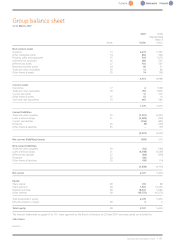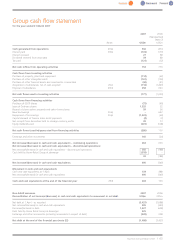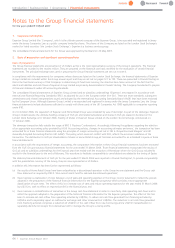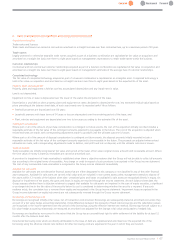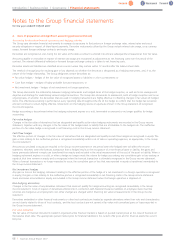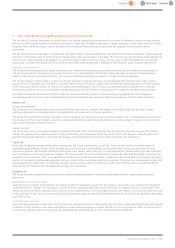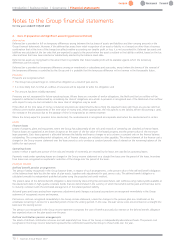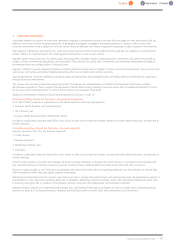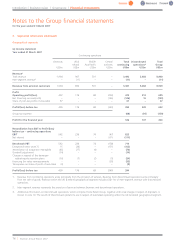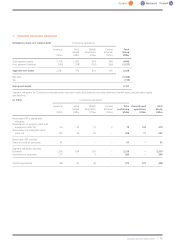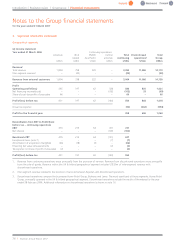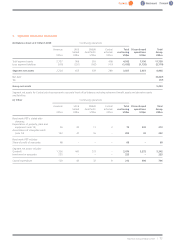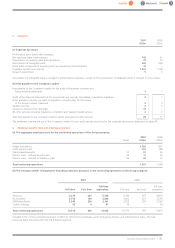Experian 2007 Annual Report Download - page 73
Download and view the complete annual report
Please find page 73 of the 2007 Experian annual report below. You can navigate through the pages in the report by either clicking on the pages listed below, or by using the keyword search tool below to find specific information within the annual report.
2. Basis of preparation and significant accounting policies (continued)
Other post-employment obligations – Post-retirement healthcare costs
The Group operates schemes which provide post-retirement healthcare benefits to certain retired employees and their dependent relatives. The
principal scheme relates to former employees in the UK and, under this scheme, the Group has undertaken to meet the cost of post-retirement
healthcare insurance for all eligible former employees and their dependants who retired prior to 1 April 1994.
The expected cost of these benefits is calculated using an actuarial methodology similar to that for defined benefit pension arrangements. Actuarial
gains and losses arising from experience adjustments, and changes in actuarial assumptions, are recognised in the Group statement of recognised
income and expense. The obligations are valued annually by independent qualified actuaries.
Critical accounting estimates and assumptions
In preparing the Group financial statements, management is required to make estimates and assumptions that affect the reported amount of
revenues, expenses, assets and liabilities and the disclosure of contingent liabilities. The resulting accounting estimates, which are based on
management’s best judgment at the date of the Group financial statements, will, by definition, seldom equal the related actual results. The
estimates and assumptions that have a significant risk of causing a material adjustment to the carrying amounts of assets and liabilities within the
next financial year are discussed below.
Taxes
The Group is subject to taxes in numerous jurisdictions. Significant judgment is required in determining the worldwide provision for income taxes as
there are many transactions and calculations for which the ultimate tax determination is uncertain during the ordinary course of business. The
Group recognises liabilities based on estimates of whether additional taxes will be due. Where the final tax outcome of these matters is different
from the amounts that were initially recorded, such differences will impact on the results for the year and the respective income tax and deferred
tax provisions in the year in which such determination is made.
Pension benefits
The present value of the defined benefit obligations depends on a number of factors that are determined on an actuarial basis using a number of
assumptions. The assumptions used in determining the defined benefit obligations and net pension costs include the expected long-termrate of
return on the relevant plan assets and the discount rate. Any changes in these assumptions may impact on the amounts disclosed in the Group’s
balance sheet and income statement.
The expected return on plan assets is calculated by reference to the plan investments at the balance sheet date and is a weighted average of the
expected returns on each main asset type (based on market yields available on these asset types at the balance sheet date).
The Group has determined the appropriate discount rate at the end of each year. This is the interest rate used to determine the present value of
estimated futurecash outflows expected to be required to settle the defined benefit obligations. In determining the appropriate discount rate, the
Group has considered the market yields of high-quality corporate bonds that are denominated in the currency in which the benefits will be paid,
and that have terms to maturity consistent with the estimated average term of the related pension liability.
Other key assumptions for defined benefit obligations and pension costs are based in part on market conditions at the relevant balance sheet dates
and additional information is disclosed in note 24.
Fair value of derivatives or other financial instruments
The fair value of financial instruments that are not traded in an active market (for example, over-the-counter derivatives) is determined by using
valuation techniques. The Group uses its judgement to select a variety of methods and makes assumptions that are mainly based on market
conditions existing at each balance sheet date.
Goodwill
Goodwill is allocated to CGUs and monitored for internal management purposes by geographical segment. The allocation is made to those CGUs or
groups of CGUs that are expected to benefit from the business combination in which the goodwill arose.
The Group tests goodwill for impairment annually or more frequently if events or changes in circumstances indicate that the goodwill may be
impaired. The recoverable amount of each CGU is determined based on value-in-use calculations.
These calculations require the use of cash flow projections based on financial budgets approved by management, looking forward up to five years.
Cash flows areextrapolated using estimated growth rates beyond a five year period. The growth rates used do not exceed the long-term average
growth rate for the businesses in which the segment operates.
Key assumptions used for value-in-use calculations for all CGUs are:
•Budgeted gross margin;
•Weighted average real growth rate of 2.25% used to extrapolate cash flows beyond the budget period; and
•Pre-tax discount rate of 11.4% applied to the pre-tax cash flow projections.
Management determines budgeted gross margin based on past performance and its expectations for the market development. The weighted
average growth rates used areconsistent with the forecasts included in industry reports. The discount rates used reflect the Group’s post-tax
weighted average cost of capital of 8%.
Experian Annual Report2007 |71


